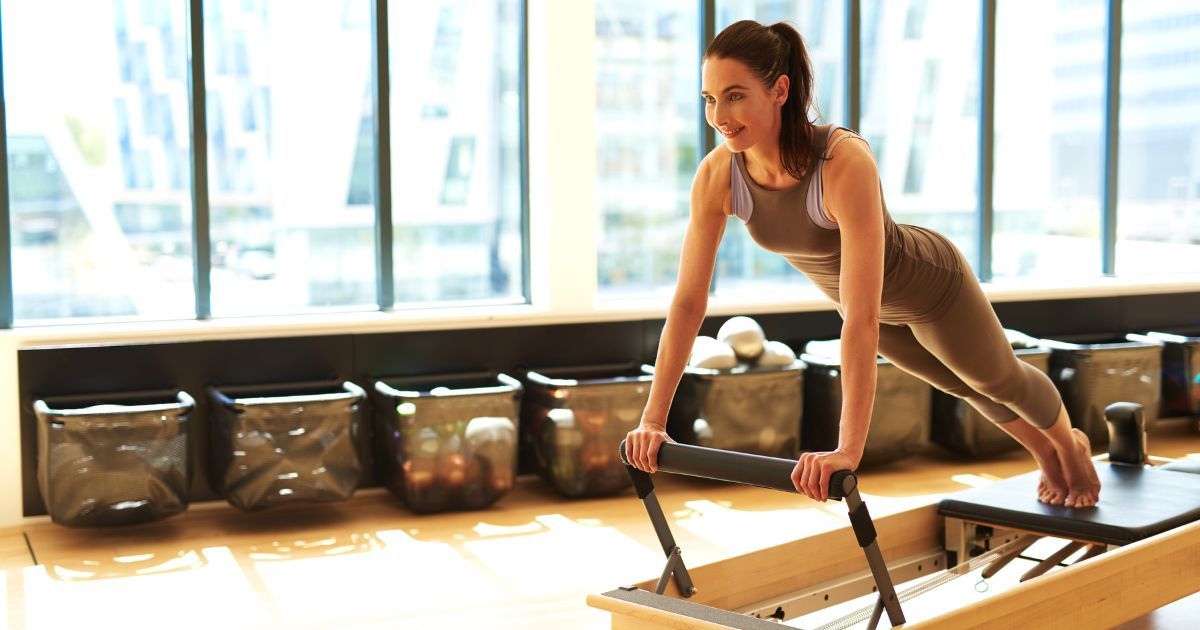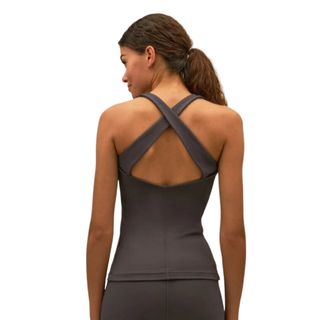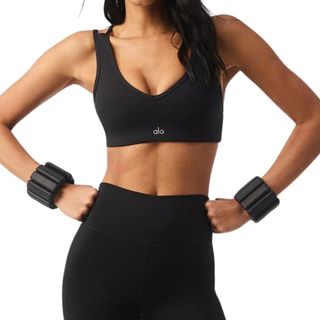Wondering what the Reformer Pilates benefits actually are? You’ve come to the right place. You’d have to be living under a very large rock not to have noticed that Reformer Pilates is everywhere, right now. Pilates has long been a celeb favourite workout, with research from Pure Gym showing that all forms of the practice are among the biggest fitness trends across the world in 2024. But recently, Reformer classes, in particular, are enjoying an explosion in popularity, with Google searches for classes soaring, and waitlists as long as your (toned and lean) arm.
Celebrity endorsements aside, Reformer Pilates also happens to have some seriously impressive benefits, too. From improving posture and alignment to promoting the mind-body connection, there’s lots to love about the workout.
For all the noise, though, you might be left wondering what on earth Reformer Pilates is – and why it’s so sought after. Keep scrolling to find out, plus – while you’re here – you might be interested to read our guide to Pilates for beginners, discover the benefits of Pilates, and find out how one of our Health Writers got on when she tried Pilates core moves every day for tone, strength and flexibility. Don’t miss our guide to how to do Reformer Pilates at home, while you’re at it.
Your expert guide to the many Reformer Pilates benefits
What is Reformer Pilates?
First things first, we asked the experts to explain what Reformer Pilates actually is.
“Reformer Pilates involves doing Pilates exercises on a spring-resisted machine,” explains physiotherapist, Pilates instructor and founder of CoreLDN, Claire Mills. “The reformer machine allows you to work against the spring resistance and your body weight creating varying levels of challenge and optimising strengthening and lengthening of muscles.”
If you’re already a fan of mat Pilates, you’ll likely recognise many of the moves in a Reformer class as the same as those practised on the mat – just with the added support, or increased tension, of springs and straps.
And at first sight, the Reformer machine is slightly terrifying, but rest assured it’s not an instrument of torute – it’s designed to support and enhance your movement, as Pilates instructor Eloise Skinner tells Fashion’s DIgest UK.
“The Reformer machine is a structure made from metal or wood, that looks a little like a bed,” she explains. “It’s made up of a foot bar at the base, the carriage – which is the moving bed-like section in the middle – a headrest, springs to provide
varying levels of tension, straps to use around hands or feet, shoulder pads and a platform (to provide a place to stand or balance, for certain sequences).”
When was Reformer Pilates invented?
If you’ve never heard the story of how modern-day Pilates came about, it’s truly fascinating. It’s well-established that the founder of the Pilates movement, German boxer and nurse Joseph Pilates, invented the practice in the early 20th Century as a
form of rehabilitation for injured WW1 soldiers. Originally, he worked on bed-bound inmates, using bed springs as a rudimentary way of adding resistance to moves – and the Reformer was born.
The rest, as they say, is history – after the war, he moved to New York, where
word of the practice spread to the dance world and beyond.
These days, a Reformer class may look very different to a prisoner of war camp – but the practice is much the same.
Which celebrities love Reformer Pilates?
It’s probably safe to say that, despite its almost instant popularity, Joseph Pilates would have had little idea that over 100 years later, his method would still be beloved by everyone, from the starriest A-lister (Kendall Jenner, we’re looking at you) to the humble health and fitness addict writing this.
Margot Robbie, Hailey Bieber, Meghan Markle – the celeb fan pages go on and on. And the popularity of hopping on the carriage isn’t limited to ladies, either – a certain Mr Harry Styles has been spotted on a machine at a swanky London studio, while LeBron James, David Beckham and Andy Murray are also rumoured to be fans. As far as celeb-spotting goes, you can’t do much better than hanging out at a Reformer class studio (not that we’d endorse such activities!).
What are the benefits of Reformer Pilates?
If your interest is piqued, you’ll be pleased to hear that the benefits of Reformer Pilates are more than just hyperbole – it’s a great way to strengthen and tone the entire body.
“Reformer Pilates is a low impact, resistance-based exercise which works on the deep core muscles and postural muscle system alongside the global muscles system to optimise overall muscle balance, control, strength and flexibility,” says Mills. “Through the spring resistance, the Reformer works muscles eccentrically
(lengthening under a load) which is required for strengthening and toning.
The springs also allow exercises to be progressed and add challenge to your
workouts and progress fitness as well as regress exercises, which is perfect
for injury rehabilitation.”
In addition, the benefits associated with a mat practice also apply to Reformer Pilates. Studies (such as this one, published in Physical Therapy & Rehabilitation Journal) show that mat and equipment-based Pilates are effective in treating back pain, while other benefits include improved core strength, greater mobility and flexibility, enhanced posture and alignment and reduced risk of injury. Enough said.
5 at-home Reformer alternatives to try, chosen by a coach
While the cost of Reformer classes can be a barrier to accessibility, (and none of us have the space for an at-home Reformer) the good news is that, with some basic props (ideally resistance bands and sliders), you can recreate an effective Reformer workout from the comfort of your living room.
With this in mind, we asked Mills for her top at-home Reformer alternative moves for you to try today. You’re welcome!
1. Resistance band mid-back variations
What? “Tie a resistance band to something sturdy overhead and lie on your back in a double table top position,” instructs Mills. “Holding each end of the resistance band at shoulder height, pull both sides of the band down by your side, then slowly control the resistance of the band back to shoulder height maintaining control in your core and not allowing the back to arch off the mat.”
Why? “This move is great for activating the deep core and abdominals,” says Mills. “Work on maintaining slow control of the resistance through the range of motion for best results.”
How long for? Repeat for 12 to 15 reps. Add in alternating single leg stretches for 12 to 15 reps, and/or add in a curl up for 12 to 15 reps.
2. Roll backs with resistance band
What? “Sit with your legs out long with a resistance band around your feet and hold each end of the band in your hands,” explains Mills. “Exhale and roll off your sit bones and create a curve through your spine sliding the rib cage down to your pelvis. Inhale and hold in the C curve, exhale to control back up. To advance, hold the C curve and exhale as you rotate, drawing the elbow back and rotating the upper back. Inhale to return to the centre and repeat alternating sides.”
Why? The Pilates roll up is a classic move in any practice, and one you’ll perform in pretty much every class. “A roll up combines core and abdominal work with upper body strength,” says Mills. “You’re challenging the control of the spine into flexion using the abdominals, so it’s also great for improving mobility.”
How long for? Mills advises repeating 12 to 15 reps.
3. Box plank to full plank with sliders
What? Begin in a four point kneeling position with sliders under feet, hover up into a box plank, then straighten your legs out into a full plank, back into a box plank then down.
Why? “This is an advanced exercise to really challenge the core – not for beginners!” advises Mills. “It’s a whole body exercise working on controlled strength – do it as slowly as you can.”
How long for? Repeat four sets of five to eight reps.
4. Scooter lunge with sliders
What? Stand in a split stance with a slider under the back foot. Keeping the back leg straight, slide it back behind you sitting into a deep lunge (knee over ankle not toes) Then stand up tall drawing the back leg and slider back in.
Why? “This is a great booty burn!” says Mills. “It works the stabilisers of the hips and the glutes.”
How long for? Mills advises 12 to 15 reps, then hold down in the lunge and slide the back leg in and out for 12 to 15 reps. Repeat twp sets on each side.
5. Standing inner thigh skater with sliders
What? “Sit into a half squat with a slider under one foot,” explains Mills. “Staying in the squat, skate the slider leg in and out underneath you holding your half squat. Then exhale as you stand up out of the squat keeping the slider leg straight as you pull the leg back in with your inner thigh, inhale and slide the leg straight out again.”
Why? “This move is a great hip strengthening and inner thigh workout,” says Mills. “Do note with all the exercises, though, that the reps and sets are focusing on endurance and strength. Some of the moves are relatively challenging, but none should be painful – so be sure to work within your comfortable range of reps and sets.”
How long for? Two sets of 12 to 15 reps on each side.
Girlfriend Collective float ultra light leggings
Looking for gym wear that’s as ethical as it is chic? Enter stage right: Girlfriend Collective. These leggings are sweat-wicking and quick-drying for workouts, yet light enough for everyday wear.



